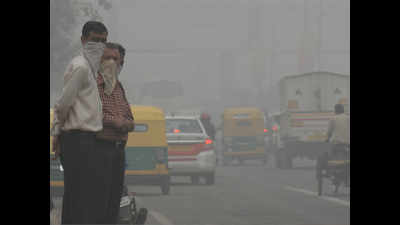- News
- City News
- delhi News
- Delhi: 18% of PM2.5 load due to stubble burning
Trending
This story is from November 12, 2019
Delhi: 18% of PM2.5 load due to stubble burning
After Monday’s 18%, the contribution of stubble burning to the capital’s air is expected to rise up to 25% on Tuesday.

Representative image
NEW DELHI: After Monday’s 18%, the contribution of stubble burning to the capital’s air is expected to rise up to 25% on Tuesday.
According to System of Air Quality and Weather Forecasting And Research (SAFAR), as on November 10, the effective stubble fire counts estimated by SAFAR-integrated multi-satellite methodology are 1,846. “The emission intrusion is expected to increase and a decrease in surface wind speed over Delhi is forecast for the next two days.In view of this, share of biomass in Delhi’s air pollution is simulated to be 25% on Monday,” SAFAR stated.
Track the pollution level in your city
The satellite analysis carried out by Union environment ministry revealed that Amritsar, Tarn Taran and Patiala, in Punjab recorded the most fire counts in 2019, while in Haryana, Karnal, Kurukshetra and Kaithal performed the worst.

On Saturday, Union environment minister Prakash Javadekar reviewed the steps taken by Delhi and neighbouring states to combat air pollution and urged the governments to stop blaming each other and start acting in synergy. The minister, who chaired a review meeting on mitigation efforts with senior officials of Delhi, Rajasthan, Uttar Pradesh, Haryana and Punjab governments, said the states have been urged to work together. “There are local factors like waste burning, dust, industrial and vehicular pollution, which contribute 70-80% to pollution,” he said, urging everyone to join the fight against pollution.
According to a recent Teri report, open biomass burning contributes 20-25% to PM2.5 in Delhi. However, experts said that stubble burning was a seasonal issue and existed only in October and November.
Meanwhile, an IIT Delhi research had revealed that east, central and northern parts of Delhi were the most affected by stubble burning in Punjab and Haryana, while south and southwest Delhi was the least impacted. “The direction of plume is from northwest to southeast over Delhi-NCR during October-November, when the stubble burning is at its peak. The meteorological conditions in this period create stagnation of particulate matter over the Indo-Gangetic plain and help build-up air pollution,” said Vimlesh Pant, professor who is working on a project on the role of geographical and meteorological data to predict air pollution, Centre of Excellence for Research on Clean Air, IIT Delhi.
According to System of Air Quality and Weather Forecasting And Research (SAFAR), as on November 10, the effective stubble fire counts estimated by SAFAR-integrated multi-satellite methodology are 1,846. “The emission intrusion is expected to increase and a decrease in surface wind speed over Delhi is forecast for the next two days.In view of this, share of biomass in Delhi’s air pollution is simulated to be 25% on Monday,” SAFAR stated.
Track the pollution level in your city
The satellite analysis carried out by Union environment ministry revealed that Amritsar, Tarn Taran and Patiala, in Punjab recorded the most fire counts in 2019, while in Haryana, Karnal, Kurukshetra and Kaithal performed the worst.

On Saturday, Union environment minister Prakash Javadekar reviewed the steps taken by Delhi and neighbouring states to combat air pollution and urged the governments to stop blaming each other and start acting in synergy. The minister, who chaired a review meeting on mitigation efforts with senior officials of Delhi, Rajasthan, Uttar Pradesh, Haryana and Punjab governments, said the states have been urged to work together. “There are local factors like waste burning, dust, industrial and vehicular pollution, which contribute 70-80% to pollution,” he said, urging everyone to join the fight against pollution.
According to a recent Teri report, open biomass burning contributes 20-25% to PM2.5 in Delhi. However, experts said that stubble burning was a seasonal issue and existed only in October and November.
Meanwhile, an IIT Delhi research had revealed that east, central and northern parts of Delhi were the most affected by stubble burning in Punjab and Haryana, while south and southwest Delhi was the least impacted. “The direction of plume is from northwest to southeast over Delhi-NCR during October-November, when the stubble burning is at its peak. The meteorological conditions in this period create stagnation of particulate matter over the Indo-Gangetic plain and help build-up air pollution,” said Vimlesh Pant, professor who is working on a project on the role of geographical and meteorological data to predict air pollution, Centre of Excellence for Research on Clean Air, IIT Delhi.
End of Article
FOLLOW US ON SOCIAL MEDIA










